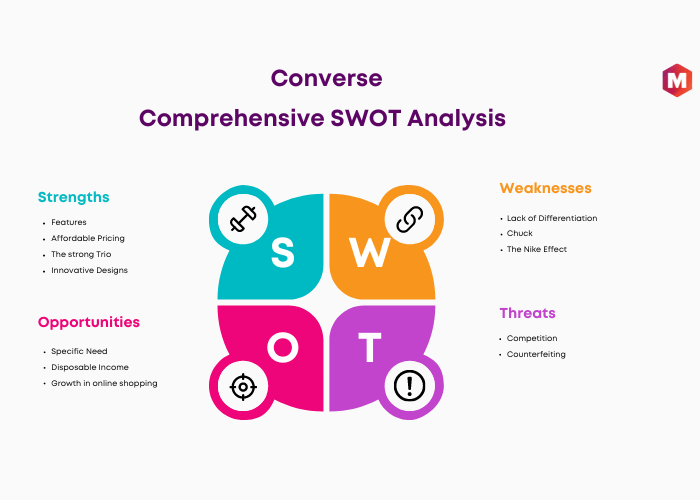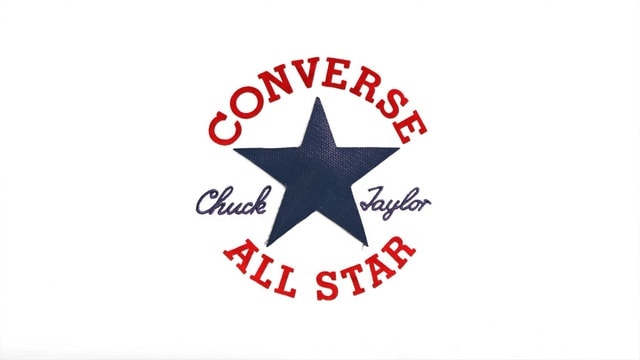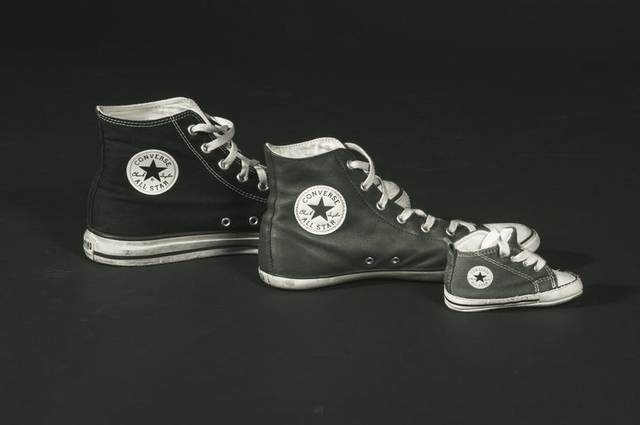Let’s explore the SWOT analysis of Converse by understanding its strengths, weaknesses, opportunities, and threats.
Converse is a footwear brand based in Massachusetts, USA, and a fully owned subsidiary of Nike. The brand became popular for its basketball shoes and also sells sportswear and apparel. The brand, which can be recognized by the star symbol it imprints on all its apparel, specializes in running and athletic shoes.
The company has a worldwide distribution network and sells through its stores, top retailers, websites, and online retail stores. Its total revenue was 2.4 billion USD in 2023, and customers perceive it as trendy and youthful.
One of Converse’s most popular products is sneakers, and some of the popular brands sold by Converse include All-Star Modern, Chuck Taylor Cons, and Jack Purcell. Known for its interesting brand names, the company is immensely popular amongst not just the youth of America but worldwide. Its top rivals include Nike, Puma, Adidas, and New Balance.
Let’s delve into some recent industry insights.
Engaging with Gen Z on Social Media: With platforms like TikTok surpassing 1 billion monthly active users in 2022 (source: Business of Apps), Converse can leverage these channels to connect with younger audiences through creative and viral content, enhancing brand visibility and loyalty.
Embracing Sustainability Trends: Consumers are increasingly prioritizing sustainability in their purchasing decisions. Converse has an opportunity to strengthen its market position by expanding its eco-friendly product lines, such as the Renew Collection, which utilizes recycled materials (source: Converse Press Release, 2022).
Overview of Converse:
- Industry: Footwear, Textile
- Founded: February 1908, 116 years ago, in Malden, Massachusetts, U.S.
- Founder: Marquis Mills Converse
- Headquarters: Boston, Massachusetts, U.S.
- Number of locations: 136 (2023)
- Area served: Worldwide
- Key people: Scott Uzzell (president and CEO)
- Brands: Chuck Taylor, All-Stars, Cons, Jack Purcell, One Star, The Weapon
- Revenue: US$2.4 billion (2023)
- Parent: Eltra Corporation (1972–1979), Allied Corporation (1979–1982), Interco (1986–1994), Nike, Inc. (2003–present)
- Website: converse.com
Table of Contents
SWOT Analysis of Converse
Strengths of Converse
1. Features
Converse Shoes are popular for their features, which make them not just trendy but also comfortable. Some such features include a vulcanized sole, rounded tip, and wrap-up strip. Converse also offers a wide variety of weightless shoes.
2. Affordable Pricing
Converse is perceived as affordable compared to its closest rivals, other than probably New Balance. The prices range from USD 55 to USD 130 in the economy segment, which is affordable to all customer categories. However, they also have many products in the premium category, which may not be affordable to everyone.
3. The strong Trio
The core strength of Nike footwear is the trio of people who back every design they make: Tokyo’s veteran tastemaker Hiroshi Fujiwara, footwear design giant Tinker Hatfield, and Nike, Inc. CEO Mark Parker. This continues to be Converse’s biggest strength.
4. Innovative Designs
Converse stands out from the crowd in its colors and styling, which is very chic and modern. Moreover, the customer vouches for the comfort of a Converse Shoe, which is one feature that makes it popular amongst athletes and runners.
Weaknesses of Converse
1. Lack of Differentiation
Though Converse has different names for different categories of shoes, it has many products on one line with minute differences that are not easy to spot. This lack of differentiation often creates confusion in customers’ minds.
2. Chuck
One of Converse’s earliest sneakers, Chuck, was named after the person who led the design. This design is considered to be the greatest of its time, and to date, no other version is comparable to its comfort and quality. Thus, Chuck will always be Converse’s biggest strength and weakness.
3. The Nike Effect
Converse will always be known as a Nike product and suffer from cannibalization by the Nike brand. This affects Converse’s overall brand equity.
Opportunities of Converse
1. Specific Need
In the early days, having one set of Shoes for all your sports needs was just enough. But that is no longer the case. Today, each need has a different solution; thus, each solution creates a demand for a new variant of footwear. This creates a whole new gamut of opportunities for the footwear industry.
2. Disposable Income
Globally, there is a surge in per capita income, with a greater number of working professionals and dual-income households. This has increased the propensity to spend, and more people are indulging in impulse shopping. All these can prove to be golden opportunities that can be targeted through the right promotional strategy.
3. Growth in online shopping
More and more prefer to shop online today; thus, shopping has become o more frequent primarily because of convenience. This has resulted in companies focusing more on the website since it also helps them cut down on distribution costs.
Threats of Converse
1. Competition
The company has always faced serious threats from Nike, Puma, New Balance, Adidas, and Reebok.
2. Counterfeiting
Numerous brands are counterfeit versions of the originals, sold at half their prices, causing a serious issue in the sales and distribution of the original brands.
Conclusion
To summarize, Converse remains a major participant in the footwear business, known for its inventive designs, low prices, and close relationship with Nike’s design skills. Despite hurdles such as product differentiation and competition from major brands such as Nike and Adidas, Converse sees chances to capitalize on changing consumer needs, rising disposable incomes, and the expanding trend of online purchasing.
To combat risks such as severe competition and counterfeiting, Converse can build on its strong brand heritage and continue to innovate to maintain its appeal among stylish and athletic footwear consumers worldwide. Converse’s focus on quality and comfort positions it well to navigate market fluctuations and maintain its dominance in the competitive footwear business.
Liked this post? Check out the complete series on SWOT


